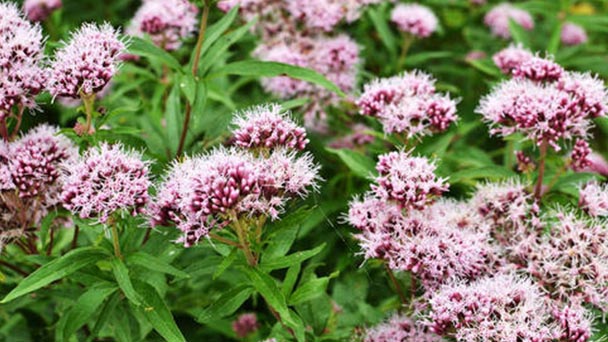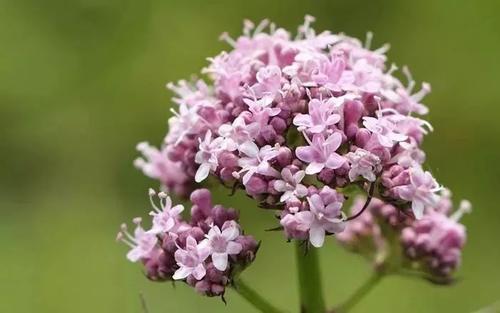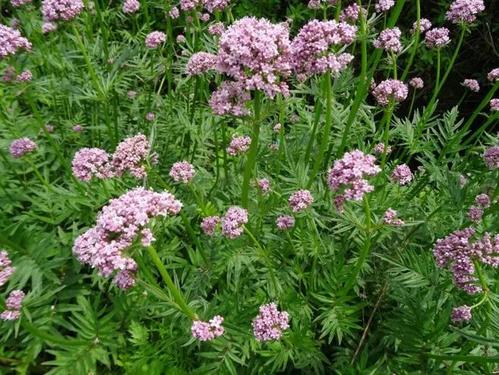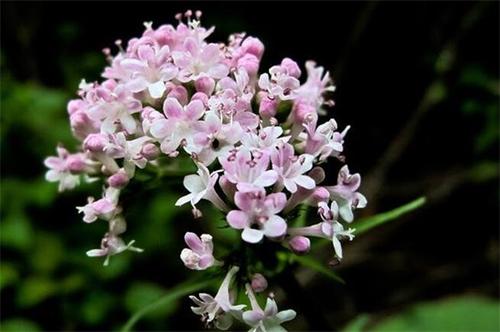Valerian profile
Written by Maggie
Jan 15 2021

Valerian is a hardy, flowering, herbaceous perennial with a height of up to 120 cm. Valerian is native to parts of Asia and Europe and cultivated in North America. Its stems and leaves are eaten by the larvae of some species of lepidoptera (butterflies and moths). Valerian rhizome and root are used for medicine, which can drive wind, relieve spasmodic, cure injury and so on. Valerian can also be used as a dietary supplement. Valerian is dipped, ground, dehydrated and then put into convenient packaging, such as capsules, for calming and anti-anxiety properties. The Valerian was used to make spices in the 16th century.
Valerian picture

Morphological characteristics of the Valerian
Rhizome
Valerian is a perennial herb; Rhizome is hypertrophic, fleshy, to 2 cm in diameter, elongated and branched. Stem base is voluminous, ascending, (15) 30 -- 120 cm tall, base diameter 2.5 -- 3 mm, obtuse four-pronged, pinstriped, sub glabrous or supra-curved to spreading puberulent, green or purplish, much branched from base.
Leaf
Valerian leaf lanceolate to linear lanceolate, 1.5 4.5 cm long, 0.5 ~ 1.2 (0.3) cm wide, apex obtuse, base rounded, margin entire, the dark green, glabrous or hydrophobic was born to carry out slightly pilose, the complexion is pale, along the midrib glabrous or slightly pilose on hydrophobic, densely glandular dots of subsidence, lateral veins 4 on, with a convex on subsidence under the midrib; Petiole is short, 2 mm long, recumbent, puberulent.
Flowers
Valerian inflorescences are terminal on stems and branches, racemose, 7 -- 15 cm long, often clustered into panicles at stem apex; Pedicels are 3 mm long, puberulent with rachis; Bracts are proximally leaflike, distally much smaller, ovate-lanceolate to lanceolate, 4 -- 11 mm long, nearly glabrous. Calyx is 4 mm long in flowering, shield 1.5 mm tall, densely puberulent outside, calyx margin sparsely pubescent, glabrous inside, calyx 5 mm long in fruit, with shield 4 mm tall. Corolla is purple, purplish red to blue, 2.3 -- 3 cm long, densely glandular pubescent on the outside, pubescent on the inside at the saclike swelling; Crown tube is near the base of obvious knee curvature, the middle diameter of 1.5 mm, up to 6 mm wide throat; Coronal is eaves 2-lipped, upper lip galeate, apex emarginate, middle lobe of lower lip triangular-ovoid, 7.5 mm wide, lobes on both sides conjunctive to upper lip. Valerian has 4 stamens, slightly exposed, anterior pair longer, with half herb, degenerative half herb is not obvious, posterior pair shorter, with whole herb, with white bearded hair on chamber cleft, back with vesicular hairs; Filaments are flattened, middle below anterior to inner posterior to bilaterally sparsely pubescent. Style is slender, apex acute, lobed. Disk annular, is 0.75 mm high, slightly enlarged anteriorly, extending posteriorly into a very short stalk of ovary. Ovary is brown, glabrous.
Fruit
Nutlets of Valerian ovoid, 1.5 mm tall, 1 mm diameter, dark brown, tuberculate, ventral near base with umbilicus.
The flowering period of Valerian is from July to August, and the fruiting period is from August to September.
The ecological habits of the Valerian
Valerian hillside grassland, under the forest ditch, below the elevation of 2500 meters, the nature likes wet, should choose high or low ground water level planting, and should have good irrigation conditions, waterlogging resistance, but also drought resistance. Neutral or weakly alkaline sandy loam is the best soil.
Valerian areas of distribution
The Valerian ranges from northeast to southwest China, up to 4000 meters in Tibet.
Valerian is also widely distributed in Europe and western Asia.
Medicines are often cultivated in nurseries throughout the Valerian.
Valerian growing methods
Choose to soil preparation
It is advisable to choose the lowland near the water source and convenient irrigation, and the sandy loam with deep soil layer, loose and fertile, good drainage and loam is advisable. Before sowing, the land was prepared by deep ploughing for 25 ~ 30cm, finely raked and leveled, combined with tilling and applying 37.5t/hm2 of decayed barnyard manure, evenly spread and plowed into the soil. Then according to the width of 1.2m, groove width 0.3m open the box, the box surface whole tile back shape, surrounded by a good drainage ditch.
Transplanting
When the seeds germinated about 1 month and the seedling height was 10cm, weeding was done again, and the plants were transplanted to the field around November. The row spacing of the plants was 20cm×30cm.

Water moisturizing
Places with plenty of rain generally don't need watering to moisturize. But occasionally after sowing such as sunny days or dry soil, should be in the compartment cover 1 layer of grass to keep the seedling soil moist; After emergence, the grass layer should be removed in time. In the early stage of seedling emergence, irrigation should be done once every 5 ~ 6 days and once every 15 days or once a month.
Weeding scarification
Weeding should be timely, see grass in addition, and can prevent the root system from bringing out seeds or seedlings. When seedlings are 5 ~ 7cm high, soil can be loosened, and the purpose of weeding can be achieved by loosening soil.V alerian roots are concentrated in the topsoil and should not be loosened too deeply. After 6 ~ 7 months, the ridge was closed, the aboveground part closed each other, the root system covered the rows, and the soil was no longer loosened. When the roots come out of the soil, the soil should be planted promptly.
Fertilizer
In general, topdressing should be done twice a year. The first topdressing should be done when the seedling height is 5 ~ 10cm, and the transplanting field should be done after greening. The second fertilization was carried out at the end of June.Apply urea 75kg/hm2 or compound fertilizer 150kg/hm2. Fertilization method is best to use furrow, that is, to open a shallow furrow about 10cm away from the plant, and cover the soil behind the furrow.
The Valerian propagation merhods
Seed propagation
Harvest in June or July when most seeds are yellowish brown, cut off the whole inflorescence and let them ripen for a few days, then shake off the seeds and dry them in the sun for later use. Valerian seeds are small and easy to fall with the wind. Seed collection should be done at the best time or in transparent krafskin paper bags to avoid seed scattering.
Sowing
Choose moist, leeward to the sun, convenient drainage and irrigation, deep and fertile soil layer of the ground or gentle slope, evenly spread every mu of decomposable farmhouse fertilizer 2500 kg, 50 kg compound fertilizer, potassium sulfate 15 kg. Then deep ploughing and raking fine, into a 1.5m wide, 20cm high box, the box surface is required to be flat, opening a good drainage ditch. Generally, autumn sowing is adopted. Seed seeding is carried out on the arranged box surface in September to the middle of October according to row spacing of 40cm and plant (nest) spacing of 20cm. The seeding depth is about 1cm. If it belongs to the high cold area above 1400m, spring plowing can be carried out in mid to late March. Valerian the first year of growth only root leaves, the second year of flowering stems. The sowing rate per mu is 0.5 ~ 1kg.
Division
It can be carried out in spring and autumn, mostly in autumn with the combination of harvesting and digging out the mother plant, breaking off the spawning buds, digging the nest according to the row spacing of 30 ~ 40cm, the plant spacing of 20cm, planting 2 ~ 3 seedlings in each nest, watering after planting, other methods for making boxes are the same as above.
Disease control of Valerian
Disease control
Valerian is dominated by wild resources, with a short history of artificial cultivation and fewer diseases. Disease is mainly Mosaic disease, the disease is more common, the seedling stage is more obvious, serious plants short not long. Prevention and control methods: one is to select and keep the disease-free plants and seeds; Second, attention should be paid to the prevention and control of field insect pests, especially aphids, so as to reduce virus transmission.
Pest control
Valerian pests mainly include mole cricket, aphids and so on. The mole cricket can be used 90% crystal trichlorfon 50 times liquid and bait with poison bait. Aphids can be used to wash powder into aqueous solution, or dichlorvos emulsion 1000 times liquid spray prevention.
Valerian's main value
Valerian is suitable for flower beds, flower borders, rock garden cultivation, and can be used as medicine or spices. The essential oil extracted from the root is Valerian oil, which is mainly used in the preparation of tobacco, wine, food, cosmetics, perfume and so on. The root decoction can be used as a gentle agent for washing face and entering the bath. It has the effect of calming the central nervous system and can be used to treat insomnia.

Latest Updated
- Benefits of Bugleweed - 7 Science-backed Health Benefits
- Bugleweed Dangers & Side Effects - Is It Poisonous?
- How to Plant Evergreen Trees - What You Should Know
- When to Plant Evergreens - Grow Guide for Evergreen Trees
- 12 Wonderful Evergreen Shrubs for Your Garden
- 12 Popular Evergreen Plants with Pictures for Beginners
- When And How To Prune A Lilac Bush Like a Pro
- How to Grow & Care for Lilac Vine (Hardenbergia Violacea)
- Japanese Lilac Tree (Syringa Reticulata) Care & Propagation Guide
- Shumard Oak Pros and Cons - What to Know
Popular Articles
- Winter maintenance of Antirrhinum Majus
- How to Grow Terminalia Mantaly Tree
- How to Grow and Care for Crossostephium Chinense
- How to grow Antirrhinum Majus in spring
- Peristeria Elata (Dove Orchid) Profile: Info & Care Guide
- Underwatered Snake Plant (Sansevieria Trifasciata) - Signs And How To Fix
- How to Care for Brazilian Jasmine Plant (Mandevilla Sanderi)
- How to Grow & Care for Graptopetalum Purple Delight in Summer
- Rosa Chinensis (China Rose): Plant Growing & Care Tips
- How to Care for Baby Sun Rose (Aptenia Cordifolia)